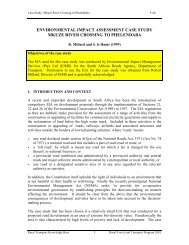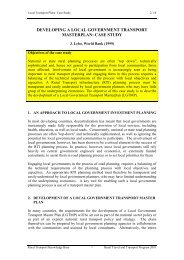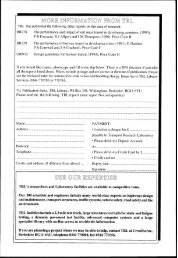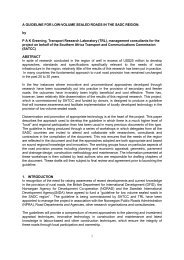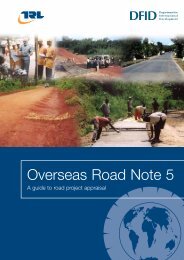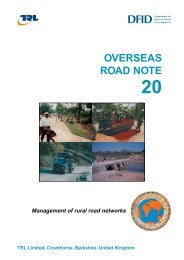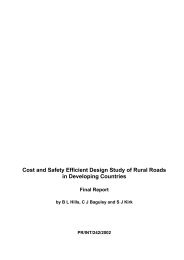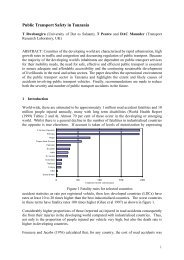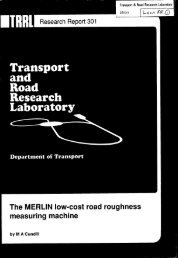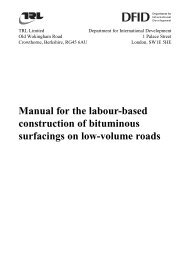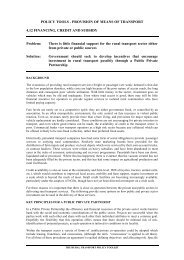PDF (607 KB) - Transport for Development
PDF (607 KB) - Transport for Development
PDF (607 KB) - Transport for Development
You also want an ePaper? Increase the reach of your titles
YUMPU automatically turns print PDFs into web optimized ePapers that Google loves.
Rural transport policytoolkitThis DFID funded project is based on a multisectoral approach to ruraltransport planning. Its objective is to take a comprehensive and systematicapproach to analysing rural transport needs and constraints of the rural poorand to identify the policy context within which interventions can be taken. Thetypes of interventions include:• Improve frequency of transport services;• Reduce transport costs;• Road/ track infrastructure maintenance through spot improvements;• Low-cost water crossings;• Non-transport interventions to reduce time and ef<strong>for</strong>t in water and firewoodcollection, such as the provision of wells and woodlots;• Interventions to address the special transport and labour burdens of women.Data collection incorporates quantitative and qualitative research methodsdesigned to address transport, livelihood, mobility and accessibility issues.Qualitative data collection is based on Participatory Rural Appraisal (PRA)techniques and institutional interviews of local and regional government personneland other political groups which have a bearing on the mobility of the villagersunder study. These groups include local co-operatives, NGOs etc.TRANSPORTRoad maintenance:people at the centreThe sustainable livelihoods approach puts people at the centre ofdevelopment. Placing an emphasis on the realistic inclusion of peopleenables them to make decisions on maintaining and improving theirlivelihoods.Coupled with trying to reach the poorer sections of communities this approachand wider influences, such as participatory approaches, has moved transportprofessionals in developing countries to look at the provision of transport in amore holistic, people centred and sustainable way. To capture experience on theabove and give guidance to engineers and planners alike, DFID funded I.T.<strong>Transport</strong> Ltd. to develop guidelines <strong>for</strong> ‘Community Participation in RoadMaintenance’. The three year project finished early this year and produced:• a literature review;• four case studies from East Africa; and,• guidelines <strong>for</strong> planners and engineers on ‘Community Participation in RoadMaintenance’.Villagers and engineers in Northern Uganda discuss access to essential servicesThe literature review took a broad look at people’s participation in manysectors, the aim being to distil best practice and raise issues <strong>for</strong> furtherinvestigation in the case studies. The four case studies were conducted inKenya, Uganda and Tanzania, and covered a range of transport interventionsand types of participation. The key issues raised from the above included:PRA meeting in ZambiaFindings from surveys carried out in Zambia highlighted extremes of poverty,vulnerability and remoteness. <strong>Transport</strong> emerged as a serious concern <strong>for</strong> the ruralpoor, particularly with regard to impact of poor accessibility and mobility on foodsecurity, agricultural marketing and af<strong>for</strong>dability of health and education.Application of the Zambian data to the Sustainable Livelihoods Frameworkindicates a need <strong>for</strong> rural transport planning to be implemented using a package ofmeasures which do not undermine existing assets. Surveys have also recently beencarried out in Cameroon. Findings will be compiled to provide a working frameworkmanual <strong>for</strong> identification of decision-making measures and policies toincrease rural mobility in Sub-Saharan Africa and beyond.For further in<strong>for</strong>mation contact: John Hine, TRLTel: +44 (0)1344 770227Email: international_enquiries@trl.co.ukDFID Projects Reference: R7457: ‘Policy Toolkit <strong>for</strong> increased Mobility’Theme Objective: T3Issue 11: November 2000• importance and type of access provided by the road had a great impact on thetype of participation and people’s willingness to participate in projectactivities;• homogeneity of the community was a large factor in the planning andimplementation stages of projects, especially in the organisation andconduct of community works; and,• the lack of participation in the past has lead to a reluctance of people to havea responsibility <strong>for</strong> community infrastructure.The guidelines were developed to tackle the above issues, which were furtherdiscussed during a regional workshop. The guidelines, available from IT<strong>Transport</strong>, are aimed at transport professionals at the implementation level whocan see the benefit of including people in the project process, but need ideas andguidance on how to do it. Funding is now being sought to conduct a similarexercise in Asia.For further in<strong>for</strong>mation contact: Marcus Wattam, IT <strong>Transport</strong>Tel: +44 (0)1325 833753Email: marcus.wattam@ittransport.co.ukDFID Projects Reference: R6476: ‘Community Participation in Road Maintenance’Theme Objective: T33
TRANSPORTDecentralization ofroad administrationin poor countriesA study of decentralization of roadadministration in poor countries has beenundertaken <strong>for</strong> DFID. This included fieldstudies in Nepal, Uganda and Zambia.The study has looked particularly at administrative decentralization, althoughissues of political, fiscal and management decentralization were also considered.Different administrative decentralization models were investigated, including thatinvolving a road fund. Recommendations are made about which models offer thegreatest chance of success in terms of their ability to reflect local priorities, theirachievement of market discipline, their scale of operations, and the simplicity oftheir decision-making linkages.Teaching children tobe safe road usersRoad accident studies in developing countriestypically show that pedestrians are highlyvulnerable road users and that children areparticularly at risk.For example approximately one-in-five of road accident fatalities in Africa arechildren under the age of 15 – about twice the rate <strong>for</strong> the United Kingdom.One way of making children safer is to provide road safety education (RSE) as partof their <strong>for</strong>mal schooling – as is the case in most developed countries. RSE needsto be progressive, relevant and practical, and teachers need to be trained in how toteach it in the classroom. Over the last decade DFID have funded anumber of research projects aimed at producing effective RSE resources <strong>for</strong>teachers, focussing on materials <strong>for</strong> primary school children, typically agedbetween 5 to 12.Evidence from the case studies suggests that decentralization has resulted in fewof the expected advantages. Whereas there are some positive outcomes resultingfrom the road sub-sector re<strong>for</strong>m process in central government, these changes arenot yet being reflected in the decentralized bodies which, to some extent, aremaking matters worse. The issue is not so much a problem of decentralization perse, but more one of how decentralization has been applied in practice. Problemsinclude a lack of local government powers to exercise political influence,insufficient financial resources, a lack of management capability, and a lack ofaccountability mechanisms.Data on poverty issues are limited, but suggest that there is little evidence ofdecentralized systems being particularly responsive to vulnerable groups,including the poor. The results conclude that decentralization, as currentlypractised, tends to rein<strong>for</strong>ce existing patterns of uneven development. Thus thestudy has not been able to establish a direct link between decentralization andimproved governance or poverty reduction. More active identification andinvolvement of the poor in the planning and implementation processes is requiredif much of the above is to be addressed.The study suggests that the basic nature of road networks makes the process ofmanaging the sub-sector more complex than <strong>for</strong> some other types of infrastructure.Furthermore, the management of maintenance, operations and renewals is morecomplex than managing new works. These findings have important implications <strong>for</strong>decentralization.For further in<strong>for</strong>mation contact: Richard Robinson or David StiedlEmail: RobinsonUK@compuserve.com or tashi@globalnet.co.ukDFID Projects Reference: R7437: ‘Decentralization of Road Administration’Theme Objective: T4DFID Newsletter and KAR project detailson the Internet:This newsletter and DFID KaR (Knowledge and Research) transportproject details are available on the Internet:www.trl.co.uk/dfid/dfid-kar-transport.htmIf you experience any difficulty with receiving your copy by post or downloading fromthe Web, we can send you the newsletter as pdf or html files by email. Please contact::International_enquiries@trl.co.uk.4Evaluating school children’s road safety awareness in PuneTRL worked with the Ghana Road Safety Council to develop and evaluatematerials <strong>for</strong> children and teachers in the final year of primary school in Ghana.This resulted in TRL Overseas Road Note 17 ‘Good Practice Guidelines’ whichprovides detailed advice and guidance to senior administrators and policy makers<strong>for</strong> providing RSE in primary schools (reported in issue 5). This was extended, incollaboration with the Central Institute <strong>for</strong> Road <strong>Transport</strong> (CIRT), with thedevelopment of materials <strong>for</strong> first year primary children in Pune in India (TRLreport 442). More recently a British Council project funded by DFID ‘UgandaIn-Country Training Programme – Developing road safety education resources <strong>for</strong>primary school children’ produced a road safety curriculum and teacher’s guide <strong>for</strong>all seven years of primary education, with materials based on the use of flip-charts- a medium particularly suited <strong>for</strong> teaching RSE to young children in poorcountries.DFID remains committed to extending this important programme to othercountries, to provide resources <strong>for</strong> children of all ages, and to those who do notattend school.For further in<strong>for</strong>mation contact: Allan Quimby, TRLTel: +44 (0)1344 770898Email: international_enquiries@trl.co.ukDFID Project References: R6890, " Road Safety Education in Developing Country Schools andCommunities"Theme Objective T1Issue 11: November 2000
TRANSPORTGlobal Road SafetyPartnership (Update)Launched in February 1999, the Global RoadSafety Partnership (GRSP) is a network ofbusinesses, civil society organisations andrelevant government ministries, workingtogether to promote road safety world-wide.Established under the World Bank’s Business Partners <strong>for</strong> <strong>Development</strong> (BPD)programme, it now has its headquarters in Geneva, where it is hosted by theInternational Federation of Red Cross and Red Crescent Societies (IFRC).GRSP receives positive support from DFID and seeks to identify and publicisegood practice and lessons learned from projects involving the business sector.GRSP is also in the process of developing and implementing new demonstrationprojects in the following countries.Africa Asia Central / Eastern Latin MiddleEurope America EastGhana India Hungary Brazil JordanSouth Africa Malaysia Poland Costa Rica LebanonZambia Thailand Romania SyriaVietnamUnder reporting ofroad traffic casualtiesThe problem of under-reporting of road accidents has long been recognised inthe UK and other highly motorised countries, but it is believed to be muchworse in low-income countries where incentives <strong>for</strong> reporting, e.g. legal orinsurance requirements, are less en<strong>for</strong>ced.DFID-funded research by TRL has studied the extent and causes of underreportingof road traffic casualties by comparing hospital data with official policerecords. The study found official statistics under-estimated the human problem,often seriously so, with reporting (i.e. the percent of hospital treated road casualtiesreported by police) estimated to range from between 3-12% in Dhaka, 17-33% inHanoi and 24-53% in Bangalore.It was recommended that road traffic casualties should be reported by hospitals ina similar manner to other major causes of illness and death. Police should givehigher priority to liasing with hospitals, and allow junior officers (both general andtraffic police) to report (but not investigate) road accidents. To avoid underestimatingthe severity of the problem, the data should refer to “reported roadtraffic accidents” and adjustment factors should be used in cost benefit analyses ofsafety measures.DFID on behalf of GRSP commissioned TRL and Ross Silcock, a member ofBabtie group, to carry out a global review of road safety management. Surveys ofcountry practices are currently underway with an aim to disseminate best practice.GRSP is always keen to learn of new examples of business sector involvement indelivering road safety programmes.For further in<strong>for</strong>mation contact: Brett Bivans, GRSP Co-ordinatorTel: +44 (0)4122 7304249 Fax: +44 (0)4122 7330395Email: grsp@ifrc.orgEstimating global road fatalitiesAs part of the GRSP programme, an update ofglobal road fatality estimates was made byTRL, co-funded by the World Bank, DFIDand TRL and reported in TRL Report 445. The reportalso includes an estimate of the economic costinvolved, regional analyses and casualty trends byage, sex and road user type.Available data were updated <strong>for</strong> 1999 and adjusted<strong>for</strong> under reporting. The revised estimates show thatabout three quarters of a million lives were lost in1999 with 86% of them occurring in low income andtransitional nations where 40% of the world’s motorvehicles are located. Road deaths are on the increasein several of the low income regions whereas roaddeaths have fallen in highly motorised countries. Theglobal cost in 1999 was estimated to be US$500billion with US$60 billion incurred in low incomeand transitional countries.Latin/CentralAmerica& Caribbean13%Asia & Pacific44%Global Road FatalitiesMiddle East &North Africa6%For further in<strong>for</strong>mation contact: Amy Aeron-Thomas, TRLTel: +44 (0)1344 770140 Email: international_enquiries@trl.co.ukDFID Project Reference: R 6883“Accident Recording, Investigation & Evaluation Systems”Theme Objective T1HighlyMotorisedCountries14%Police reporting details of truck accident in JamaicaAfrica11%Central/EasternEurope12%Males were found to account <strong>for</strong> the majority of roadfatalities, most of which occur in the prime of life.While females may not be the primary victim, they areoften affected by the loss of a husband or father whichcan have devastating effects (both financial andsocial) on a family.The study highlighted the limitations of policestatistics and the limited use of accident data. Itrecommends the use of alternative safety indicators,such as the number of safety audits or number ofremedial measures implemented and places lessreliance on casualty statistics with more priority beinggiven to the collection of injury data, especially byhospitals. It also urges more research to beconducted on the dissemination and application ofaccident data in low-income countries.For further in<strong>for</strong>mation contact: Goff Jacobs orAmy Aeron-Thomas, TRLTel: +44 (0)1344 770943Email: international_enquiries@trl.co.ukIssue 11: November 20005
TRANSPORTImproving soil engineering properties with additivesInvestment in road infrastructure in developingcountries has recently been concentrated in ruralareas, where roads are relatively lightly trafficked(below 200 vehicles per day). These roads are oftenconstructed with locally available, sub-standardmaterials, more susceptible than standard materials toerosion or de<strong>for</strong>mation by traffic in wet weather.Increasingly, proprietary chemical stabilisationproducts including ionic soil stabilisers such assulphonated petroleum products (SPP’s) are beingmarketed as a cost effective solution <strong>for</strong> improving thedurability of rural paved and unpaved roads. Most ofthe products available on the market claim to improvecompaction, strength and durability of the roadbuildingmaterials. TRL, in collaboration with theCSIR in South Africa, have undertaken a DFIDfundedstudy to examine the effects of additives on arange of materials and develop a strategy wherebyengineers can make rational judgement on theselection and use of such additives. Field studiescarried out in South Africa and the Middle East haveshown that, where additives have been used, bothdensities and strengths can be significantly higherthan control sections containing no additive. Ifadditives are to be used routinely, practitioners need tofully understand:Better design <strong>for</strong> highway slopes in tropical soilsTropical residual soils are <strong>for</strong>med in place by the profound weathering ofparent rock and generally exhibit good strength characteristics because ofgood interparticle bonding and matric suction in the unsaturated zone.However, heavy downpours penetrate into the exposed soil in slope cuttings,especially on newly constructed slopes, reducing its shear strength and oftenresulting in major landslides and sometimes loss of life.• composition of the various products(most manufacturers remain secretive about thecomposition of the additives)• how and why they react with particular soils andimportantly, why in some cases they do not• suitability of standard engineering procedures toevaluate product suitability (standard tests such asCBR are only effective where significant strengthchanges occur)• methodology of mix design (matching products tosoils and in the correct concentrations) and thesuitability of existing specifications• environmental and safety issues (SPP’s are acidbased)• working methods and curing procedures• life cycle cost analysis based on controlledper<strong>for</strong>mance studiesMuch of this in<strong>for</strong>mation is generally made availableto the practitioner by the manufacturers or theirrepresentatives. However, the advice being issued as aresult of the research to date is <strong>for</strong> practitioners to seeka product per<strong>for</strong>mance guarantee from the supplierswhen contemplating the use of chemical additives. Todevelop confidence in the use of these stabilisers andto <strong>for</strong>mulate acceptable per<strong>for</strong>mance guaranteecriteria, data need to be collected from properlyresearched and controlled field per<strong>for</strong>mance studies.Additive being applied with compaction waterFor further in<strong>for</strong>mation contact: Tony Greening, orColin Gourley, TRLTel/Fax: +263 4 4726631, +44 (0) 1344 770491Email: international_enquiries @trl.co.ukDFID Projects Reference: R6896: ‘Innovative compaction technology<strong>for</strong> low volume roads’Theme Objective: T2The proposed methodology utilises already available software together withfundamental knowledge of how residual soils behave. The basic model <strong>for</strong> slopestability analysis is shown in the graphic. The methodology of analysis is as follows:• Wetting band (deteriorated zone due to water infiltration) is calculated usingstandard geotechnical data.A recent DFID-funded research project has developed a methodology <strong>for</strong>optimising slope designs through these soils, in terms of safety (minimise thelikelihood of failure) and economics (minimise construction and maintenancecosts). The research suggests that safer and more economical slopes can beachieved by constructing at, or close to, the vertical in some residual soils.• Slope analyses are run using appropriate soil properties <strong>for</strong> the wet and dry zoneand the resulting factors of safety are converted into failure probabilities.• Failure probabilities <strong>for</strong> highway cuts are calculated.• Distribution of failure probability with age of highway cut is calculated.h'wet'rainintensityh'wet'• Whole life cost analysis is carried out based on failure probability andconstruction/maintenance costs using a suitable discount rate.'dry'iInclined cutWetting band modelH'dry'failuresurfaceVertical cutHGeotechnical data <strong>for</strong> Malaysian, Kenyan and Zimbabwean soils have been usedto validate the methodology with promising results. The new design approach couldproduce optimal highway cuts in residual soils, resulting in reduced whole life costs.In addition to producing direct savings <strong>for</strong> the highway authority, this technique canaid improved road condition and access.For further in<strong>for</strong>mation contact: Dr C Holt, University of BirminghamTel: +44 (0)121 4145142 Fax: +44 (0)121 4143674Email: c.c.holt@bham.ac.ukDFID Projects Reference: R7114: ‘Optimisation of Cuts in Residual Soils’Theme Objective: T26Issue 11: November 2000
TRANSPORTImplementing HDM-4 across the worldHDM-4, the Highway <strong>Development</strong> aManagement System, is software <strong>for</strong> investigatingroad investment choices. It will enable managers ofroad network assets to investigate the possibilities <strong>for</strong>providing cost-effective development and upkeep oftheir road system, bringing benefits to thecommunities that they serve.The World Road Association (PIARC) manages theInternational Study of Highway <strong>Development</strong> andManagement Tools - the ISOHDM Project. Its currentfocus is on:• producing and disseminating product updates;• fostering training and dissemination activities;• fostering the growth of HDM-4 regional andinternational user communities;• supporting the ever-growing HDM-4 In<strong>for</strong>mationCentre on the World Wide WebThe HDM-4 products, which include the HDMSeries documents, the HDM-4 software andassociated case study data sets, were released inVersion 1.0 in March 2000 with an update (Version1.1) issued in August 2000. So far, almost 500 copiesof the software have been purchased.The global distribution of interest from potentialusers, as shown by almost 700 registrations from 106countries, is shown in the figure. While HDMtechnology is equally suitable <strong>for</strong> application in bothdeveloped and developing countries, PIARC has aparticular interest in encouraging its use in developingcountries and transition economies. A total of 61 ofthese special consideration countries accounts <strong>for</strong>31% of the interests expressed by individuals.ISOHDM encourages and coordinates trainingactivities provided by local training suppliers in allregions of the world, and already training orawareness events have been scheduled in at least 21countries.A major training project has been the developmentand delivery of a broad Training and DisseminationStrategy in the Asian region. Currently, ISOHDM ispromoting a similar training strategy development <strong>for</strong>the Latin American region, with TRL guidance.The <strong>for</strong>mation and growth of country or regional usergroups is encouraged. These can bring benefitsthrough coordination of local calibration andcustomisation ef<strong>for</strong>ts, publication of regional casestudies and localised default data sets, and other userinteractions. Organised regional user activities arestarting to emerge, <strong>for</strong> example in northern andeastern Europe, Australia, Japan and in the LatinAmerican region.North America12%Oceania8%Regional Distribution of All InterestsLatin America& Caribbean18%East/South EastAsia8%South Asia5%HDM-4 training in AsiaThe Asian <strong>Development</strong> Bank (ADB) have let acontract <strong>for</strong> Training and Dissemination ofHDM-4 in the Asia Pacific Region. The project,awarded to TRL, in association with the Centre <strong>for</strong>Rural <strong>Development</strong> and Training at W olverhamptonUniversity (CRDT), University of Birmingham andIKRAM, the institute of training and research inMalaysia, aims to achieve a sustainable approach tothe adoption and effective use of HDM-4 in theregion.The project has three key objectives: to develop atraining and development strategy <strong>for</strong> HDM-4 <strong>for</strong> thenext 5 years, to develop training and disseminationmaterials in support of this strategy and to deliver atraining programme in the Asia Pacific region.The project is now in the second phase. A strategy hasbeen developed and a Train the Trainers course held atIKRAM <strong>for</strong> 25 selected trainers from 9 countries inthe region. The project will now provide support to thein-country courses to be held in these target countries,aiming to provide sustainable development andimprovement of road management.For further in<strong>for</strong>mation contact:Greg Morosiuk, TRLTel: +44 (0)1344 770036E-mail: international_enquiries@trl.co.ukAfrica11%Central/NorthAsia2%Western Europe23%Central/EasternEurope10%Middle East3%PIARC’s HDM-4 web site at http://hdm4.piarc.orgprovides in<strong>for</strong>mation about the ISOHDM project andHDM-4 products, user support in<strong>for</strong>mation, access tothe user resources and contact network, ISOHDMdocuments, and a resource download service.For further in<strong>for</strong>mation contact: ISOHDM ProjectSecretariat at the World Road Association,Tel: +33 (0)147 968187Fax: +33 (0)149 000202Email: hdm4@piarc.orgWeb Site: www.hdm4.piarc.orgElectronic conference onurban public transportEntitled “Urban public transport and sustainablelivelihoods”, this electronic conference tookplace by email during September and October2000. Its aim was to discuss issues related to thelinkages between urban public transport and‘sustainable livelihoods’ and to present findings froma DFID funded research project “Partnerships toImprove Access and Quality of Public <strong>Transport</strong> <strong>for</strong>the Urban Poor”, a study based in Karachi, Pakistan.A report entitled “Urban public transport andSustainable Livelihoods <strong>for</strong> the poor” a case study:Karachi,Pakistan, is available from LoughboroughUniversity.Approximately 100 participants took part in the firstphase which was led by Dr Sohail of WEDC, whoencouraged and provided the stimulus <strong>for</strong>participation by suggesting topics and ideas whichemanated from the research findings and DFID’s ownideas and perceptions on the Sustainable Livelihoodsapproach.Further phases included a discussion of the lessonslearned and future direction of research in this areaand were equally successful. The e-conference <strong>for</strong>matbrought together various stakeholders, such as NGO’s,researchers, government staff and consultants, todiscuss practical elements behind urban transportprovision, and provided an opportunity to voicecomments and share experiences in relation to urbanpublic transport services. A synthesis report will beproduced and although the conference has ended, the<strong>for</strong>um will remain open <strong>for</strong> further discussions.For further in<strong>for</strong>mation contact: Dr. M.Sohail, WEDCTel: +44 (0)1509 222885E-mail: M.Sohail@lboro.ac.ukWeb Site:www.infolboro.ac.uk/departments/cv/wedc/indexREAAA Tokyo 2000The 10 th Conference of the Road EngineeringAssociation of Asia and Australia (REAAA)was held in Tokyo, Japan, in September, 2000.The main theme of the event was “Road development<strong>for</strong> the 21st Century” with particular attention givento the new challenge of optimising the allocation ofinvestment under the critical economic situationprevailing in Asia.Seven papers were contributed by TRL on DFIDfunded projects, some of which were co-funded bythe World Bank and the Indonesian Government.These are listed on page 8 of this newsletter.For further in<strong>for</strong>mation contact: TRLEmail: international_enquiries@trl.co.ukIssue 11: November 2000 7
TRANSPORTBOOKSUrban Public <strong>Transport</strong> and Sustainable Livelihoods <strong>for</strong> the Poor- A Case Study: Karachi, Pakistan. Edited by M Sohail, WEDC,ISBN: 0 906055 76 8, Price £14.96 + P&P. Available fromWEDC.Taking Steps - A Community Action Guide to People -Centred,Equitable and Sustainable Urban <strong>Transport</strong>. by A Rahman,P Barter and T Raad, The SUSTRAN Network,Price US$7 <strong>for</strong> developing countries, US$12 <strong>for</strong> OECD countries.Available from the SUSTRAN Resource Group.PAPERSPA3634/00 DAVIS, A.<strong>Transport</strong> and sustainable rural livelihoods in Zambia: A casestudy. Eighth regional seminar <strong>for</strong> labour-based practioners,Cairo, Egypt, 15-19 October 2000.PA3623/00 PEARCE, T and D A C MAUNDER.Public transport safety in four emerging nations. 5th WorldConference on Injury Prevention and Control, New Delhi, India, 5 -8 March 2000.PA3622/00 GRANNE, Y H, B L HILLS, E P WALTEROS and S HPEREZ. Road safety in urban Santa Fe de Bogota D.C CODATU IXConference, Mexico City, 11 - 14 April 2000.PA3610/00 HINE, J and J RUTTER.Roads, personal mobility & poverty: The Challenge. <strong>Transport</strong> andPoverty Alleviation Workshop, Washington D.C. 13 June 2000.PA3601/00 HINE, J L, H P SINAGA and D D RUDJITO.<strong>Transport</strong> costs <strong>for</strong> highway planning in Indonesia: results fromnew research into speed and fuel consumption in congestion, valuesof passenger time and vehicle maintenance costs. 10th REAAAConference, Tokyo, Japan, 4 - 9 September 2000.PA 3594/00 KIRK, S, EDWARDS, A C and J SESE. Making gooduse of volcanic ash in the Philippines. 10th REAAA Conference,Tokyo, Japan, 4 - 9 September 2000.PA3579/00 ROLT, J and C PARKMAN. Characterisation ofpavement strength in HDM-III and changes adopted <strong>for</strong> HDM-4.10th REAAA Conference, Tokyo, Japan, 4 - 9 September 2000.PA3578/00 MOROSIUK, G, T TOOLE, S MAHMUD and TDACHLAN. Modelling the deterioration of bituminous pavementsin Indonesia a HDM-4 framework. 10th REAAA Conference,Tokyo, Japan, 4 - 9 September 2000.PA3575/00 DALY, A F and W WITARNAWAN. A method <strong>for</strong>increasing the capacity of short and medium span bridges. 10thREAAA Conference, Tokyo, Japan, 4 - 9 September 2000.PA3574/00 PEARCE, T and D A C MAUNDER. The causes ofbus accidents in five emerging nations. 10th REAAA Conference,Tokyo, Japan, 4-9 September 2000.PA3570/00 FORD, W G, H R SMITH, R C ASIS, A S IDABAGAand B S T CYR. Preliminary results of the accelerated ageing ofmodified and unmodified bituminous binders using the pressureageing vessel. 10th REAAA Conference, Tokyo, Japan, 4 - 9September 2000.Recent publicationsREPORTSGuidelines <strong>for</strong> engineers and planners <strong>for</strong> communityparticipation in road maintenence. Available from IT <strong>Transport</strong>Ltd.ODI <strong>Transport</strong> and poverty report (June 2000).Available in pdf <strong>for</strong>mat only from ODI website:www.odi.org.uk/pppg/poverty.htmlODI <strong>Transport</strong> and poverty toolkit (June 2000).Available in pdf <strong>for</strong>mat only from ODI website.TRL 445Jacobs, G, A Aeron-Thomas and A Astrop. Estimating globalroad fatalities.TRL 442Sayer, I A, A Quimby, G Murray and J Guy. Improving road safetyeducation (RSE) in developing countries: IndiaFor copies of the above publications please contact TRL unlessotherwise stated. Limited numbers of TRL publications on DFIDfundedresearch are free of charge to nationals of developingcountries. A full list of TRL’s International publications isavailable on the TRL Web site: www.trl.co.uk/pubsoseas.htmContact addressesDFID, 94 Victoria Street ,London, SW1E 5JL UKFax:+44(0)207 917 0072 www.dfid.gov.ukGRSP Secretariat, PO Box 372, 17 Chemin des Crets, Ch-1211Geneva 19, Switzerland Fax: +41 22 733 03 95www.worldbank.org/bpdIDS, Institute of <strong>Development</strong> Studies, University of Sussex,Brighton BN1 9RE. U.K. Fax: +44 (0) 1273 621202IT <strong>Transport</strong> Ltd. The Old Power Station, Ardington Nr. Wantage,Ox<strong>for</strong>dshire OX12 8QJ. U.K. Fax: +44 (0) 1235 832186ODI, Portland House, Stag Place, London SW1E 5DP U.K.Fax: +44 (0)207 922 0399 www.odi.org.ukSUSTRAN Resource Centre, P O Box 11501, Kuala Lumpur 50748Malaysia, Tel/fax: + 60 3 227 42590E.mail: sustran@po.jaring.my www.malaysiakini/com/sustranTRL, Old Wokingham Road, Crowthorne, Berkshire R45 6AU. U.K.Fax: +44 (0)1344 770356 www.trl.co.ukUniversity of Birmingham, Edgbaston, Birmingham B15 2TT. U.K.Fax: +44 (0)121 414 3675/5160 www.bham.ac.ukWEDC, Loughborough University, Leicestershire LE11 3TU. U.K.Phone: + 44 (0) 1509 222885 Fax: + 44 (0) 1509 211079Email: WEDC@lboro.ac.uk www.lboro.ac.ukThe World Bank,1818 H Street NW, Washington DC 20433 USAFax: +1 202 522 1500 www.worldbank.orgWorld Road Association (PIARC / AIPCR), La Grande Arche, ParoiNord (niv 8), 92055 La Defense FRANCEFax: +(33) 1 49 00 02 02 www.hdm4.piarc.orgNewsletter Editors<strong>Transport</strong>Linda Parsley, International DivisionTRL Limited, Old Wokingham Road, Crowthorne, BerksRG45 6AU, UKTel: +44 (0) 1344 770551 Fax: +44 (0) 1344 770356Email: international_enquiries@trl.co.ukWeb Site:www.trl.co.uk/dfid/dfid-kar-transport.htmEarthworksDavid Greenbaum, British Geological Survey, KeyworthNottingham NG12 5GG, UKTel:+44 (0)115 936 3224 Fax:+44 (0) 115 936 3474Email:d.greenbaum@bgs.ac.ukWeb Site:www.bgs.ac.uk/dfid-kar-geoscience/Energy EfficiencyClive Caffall, ETSU, 156 Harwell, DidcotOx<strong>for</strong>dshire OX11 0RA, UKTel: +44 (0)1235 433591 Fax: +44 (0)1235 433548Email: clive.caffall@aeat.co.ukWeb site: www.etsu.com/dfid-kar-energy/UrbanisationDarren Saywell, WEDCLoughborough University, Leicestershire LE11 3TU, UKTel: +44 (0)1509 222885 Fax: +44 (0)1509 211079Email:d.l.saywell@lboro.ac.ukWeb site: www.lboro.ac.uk/garnet/urbankar/dfid-karurban.htmlWaterGeoff Pearce, Overseas <strong>Development</strong> Unit, HR Walling<strong>for</strong>dHowbery Park, Walling<strong>for</strong>d, Oxon OX10 8BA, UKTel:+44 (0) 1491 835381 Fax:+44 (0)1491 826352Email:odunit@hrwalling<strong>for</strong>d.co.ukWeb Site: www.hrwalling<strong>for</strong>d.co.uk/projects/dfid-kar-water.htmlOverseas Road Note 1- planned new editionAnew edition of TRL’s ORN1: MaintenanceManagement <strong>for</strong> District Engineers isplanned. The revision will bring the documentup to date (last revised in 1987), but how this is doneis very much up to current and future users.Is ORN1 useful? How could it be improved? Whatextra would you like to see? What parts of the roadnetwork should it address?We would like to make contact with ORN1 users andothers who have an opinion about it. Please emailSimon Done (sdone@trl.co.uk), or fax/write to theTRL address. This is your opportunity to make yourviews known so that the final document provides whatyou as road engineers and managers really need.We look <strong>for</strong>ward to your interest.This newsletter is available free of charge, aimed at those who are interested in <strong>Transport</strong> related issues in the developing world. To be included on the mailinglist <strong>for</strong> future editions, please send your name and address to the editor or use the application <strong>for</strong>m now available on the TRL World Wide Web Page:www.trl.co.uk/dfid/orcmail.htm.To optimise the dissemination process, it is important that this newsletter is reaching the right people. Please in<strong>for</strong>m the editor of changes in address details orif you no longer want to remain on the mailing list.Published by the International Division TRL, on behalf of the Department <strong>for</strong> International <strong>Development</strong>. Printed on recycled paper.Issue 11: November 20008



